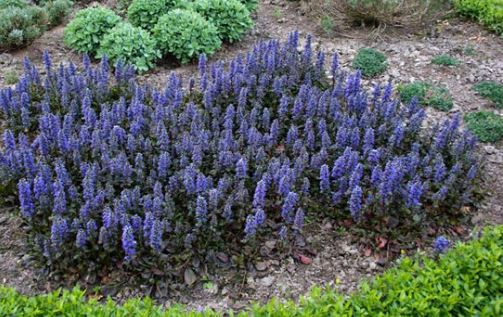
Ajuga reptans is commonly known as bugle, blue bugle, bugleherb, bugleweed, carpetweed, carpet bugleweed, and common bugle, and traditionally however less commonly as St. Lawrence plant. It is an herbaceous flowering plant in the mint family Lamiaceae, native to Europe. It is also a component of purple moor grass and rush pastures, a Biodiversity Action Plan habitat in the United Kingdom.
Ajuga reptans features rosettes of leaves that can vary from dark green to purple, bronze, or variegated patterns of green and white or pink. The leaves are oval to lance-shaped, with a glossy texture. It produces upright spikes of tubular flowers that rise above the foliage. Flowers are usually blue but can also be found in purple, pink, or white. They bloom in late spring to early summer. The flowers are frequently visited by flies, such as Rhingia campestris.
It spreads through stolons (above-ground runners) and underground rhizomes, creating a dense, carpet-like mat. Each plant can grow to about 3-6 inches in height, but its spread can cover much larger areas. This plant is often semi-evergreen to evergreen in milder climates, maintaining green cover throughout the winter.
Active growth occurs in spring, leading to flowering. While it’s semi-evergreen to evergreen, depending on local climate, it might look a bit ragged in colder winters but usually recovers quickly in spring.
Ecological and Practical Uses
- Excellent for suppressing weeds and covering bare ground, especially in shaded or difficult-to-grow areas.
- Its colorful foliage, especially in variegated or deep purple forms, adds visual interest year-round. The flowers provide a spring bloom.
- Effective for preventing soil erosion on slopes due to its dense, mat-forming growth habit.
- Historically used in herbal medicine for its astringent and anti-inflammatory properties, though modern use is more ornamental than medicinal.
Cultivation
- Typically hardy in USDA zones 3 to 9, it can withstand both cold winters and hot summers.
- Prefers partial to full shade but can tolerate full sun, especially in cooler climates or if the soil is kept moist. In full sun, however, the foliage might not maintain its deep color.
- Highly adaptable to various soil types, including clay, sandy, and loamy soils. It thrives in well-drained, humus-rich soils but can handle less ideal conditions.
- While it’s somewhat drought-tolerant once established, it performs best with consistent moisture. However, it doesn’t appreciate waterlogged conditions.
- In colder climates, the foliage might die back, but the plant usually regrows vigorously in spring from the root system.
- Best planted in spring or early fall to allow time for establishment before extremes of heat or cold.
- The species is monoecious, with male and female flowers on the same plant. Pollination is by bees or Lepidoptera (moths and butterflies)
Propagation
- Division: Easily propagated by dividing clumps in spring or fall.
- Cuttings: Stem cuttings can also be taken in spring or late summer and rooted in soil or water.
- Seeds: Less common, but seeds can be sown in spring, though they might not produce plants with the same characteristics as the parent if it’s a hybrid or cultivar.
Pest and Diseases
- Slugs and Snails: These might be attracted to the lush foliage, especially in damp conditions.
- Aphids: While not common, aphids can occasionally infest Ajuga, especially new growth.
- Spider Mites: More likely in very hot, dry conditions.
- Leaf Spot (Fungal): This can appear as brown or black spots on leaves, particularly in humid conditions or if foliage remains wet for extended periods.
- Root Rot: Caused by overly wet soil conditions, leading to fungal infections.
- Powdery Mildew: Less common but can occur in high humidity or poor air circulation.
- Crown Rot: Sometimes seen in established plants if soil conditions become too soggy.